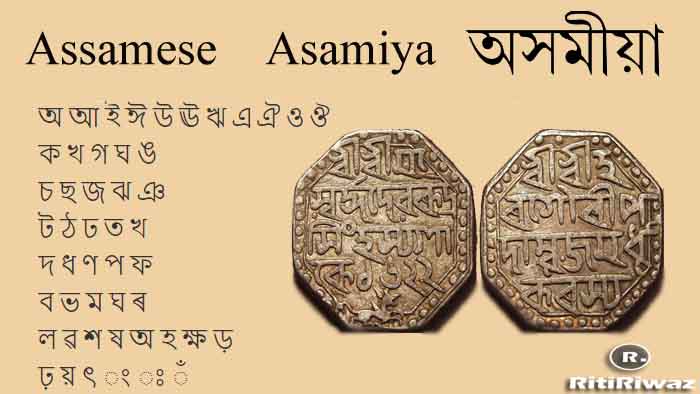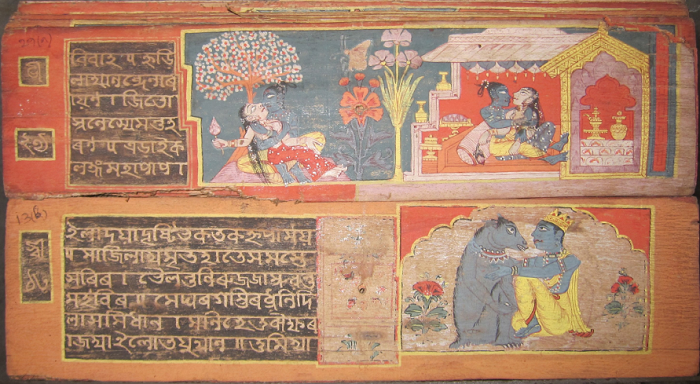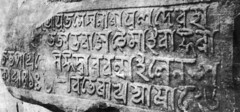Assamese language | Language in Assam

Assamese is an Eastern Indo-Aryan language used mainly in the state of Assam. It is the state language as well as the official language of Assam. Assamese which is also known as Asamiya (Oxomiya) is spoken in the Indian state of Assam, Meghalaya, Arunachal Pradesh, and also in Bangladesh & Bhutan. It is the mother tongue/language of Assamese people.
The Assamese language is spoken mainly by the people of Assam and also by some people of other NorthEast states. Nearly 15 to 20 million people residing along the Brahmaputra valley speak Assamese. It is one of the recognized languages of India.
The English word “Assamese” is built on the same principle as “Japanese”, “Taiwanese”, etc. It is based on the English word “Assam” by which the tract consisting of the Brahmaputra valley is known. The people call their state Oxom and their language Oxomiya.
Suggested Read: Assam – Culture, and Tradition
History

The history of the Assamese literature may be broadly divided into three periods:
1. Early Assamese (6th to 15th century AD): The Charyapadas are the earliest examples of the Assamese.
2. Middle Assamese (17th to 19th century AD): This period is of prose chronicles (Buranji) of the Ahom Court.
3. Modern Assamese: There has been the influence of British rule and Missionaries in this period.
The word ‘Assamese’ is an English one based on the anglicized form ‘Assam’ from the native word ‘Asam’. The word Assam was connected with the Shan (Sham) invaders of the Brahmaputra valley during the 13th century. In the modern Assamese, Shan invaders of the 13th century are termed as ‘Ahoms’.
The Assamese language is evolved in the 7th century AD having its roots from the Sanskrit language. However, its vocabulary, phonology, and grammar have been substantially influenced by the original inhabitants of Assam, such as Boros and the Kacharis.
The Assamese script is derived from the Brahmi script. The rock inscription and copper plate from the 5th to 9th centuries showed the evolution of the Assamese script. The Assamese language is written using Assamese scripts that are developed from the Gupta alphabets around 1200 AD and which closely resemble the Mithilakshar and Bengali alphabets.
Suggested Read: Me-dam-me-phi
Formation of Assamese
Assamese and cognate languages, Maithili, Bengali, and Oriya developed from Magadhi Prakrit. According to linguist Suniti Kumar Chatterji, the Magadhi Prakrit in the east gave rise to four Apabhramsa dialects: Radha, Vanga, Varendra and Kamarupa, and the Kamarupa Apabhramsa, keeping to the north of the Ganges, gave rise to the North Bengal dialects in West Bengal and Assamese in the Brahmaputra valley.
Since the time of the Charyapada, Assamese has been influenced by the language belonging to the Sino-Tibetan and Austroasiatic families. Assamese became the court language in the Ahom kingdom by the 17th century.
Assamese Writing

Assamese uses the Assamese script, a variant of the Eastern Nagari script, which traces its descent from the Gupta script. There is a strong tradition of writing from early times. Examples can be seen in edicts, land grants, and copper plates of medieval kings.
Assam had its own system of writing on the bark of the Sanchi tree in which religious texts and chronicles were written. The present-day spelling in the Assamese is not necessarily phonetic. Hemkosh, the second Assamese dictionary, introduced spellings based on Sanskrit which are now the standard.
Suggested Read: Manas National Park
Assamese Dialects
In the middle of the 19th century, the dialect spoken in the Sibsagar area came into focus because it was made the official language of the state by the British and because the Christian missionaries based their work in this region. Now the Assamese spoken in and around Guwahati, located geographically in the middle of the Assamese spoken region, is accepted as the standard Assamese.
There are four dialects in the Assamese language listed from east to west.
1. Eastern group, spoken in and other districts around Sibasagar district.
2. The central group spoke in the present Nagain district and adjoining areas.
3. Kamrupi group is spoken in undivided Kamrup, Nalbari, Barpeta, Darrang, Kokrajhar, and Bongaigain districts.
4. Goalparia group is spoken primarily in the Dhubri and Goalpapa districts and in certain areas of Kokrajhar and Bongaigaon districts.
Suggested Read: Kaziranga National Park
Literature
Assamese literature is the entire corpus of poetry, novels, short stories, documents, etc. written in the Assamese language. It also includes such writings and popular ballads in the older forms of the language during its evolution to the contemporary form.
The rich literary heritage of the Assamese language can be traced back to the 6th century in the Charyapada, where the earliest elements of the language can be discerned. The Charyapadas is often cited as the earliest example of Assamese literature. The earliest known Assamese writer is Hema da Charita. Another poet Rudra Kandali translated Drona Parva into Assamese. Madhav Kandali was a well-known poet who rendered Valmiki Ramayana into Assamese verse. 17th to 19th Century AD is the period of Akom who had brought with them an instinct for historical writings.
In Ahom court, historical chronicles were at first composed in their original Tibet-Chinese language, but when Ahom rulers adopted the Assamese as the court language, historical chronicles began to be written in Assamese. The British imposed Bengali in 1836 in Assam, but due to sustained campaign Assamese was reinstated in 1873 as the state language. The initial printing and literacy activity occurred in eastern Assam, and the eastern dialect soon came to be formally recognized as the standard Assamese.
Suggested Read: Nicknames of Indian States






